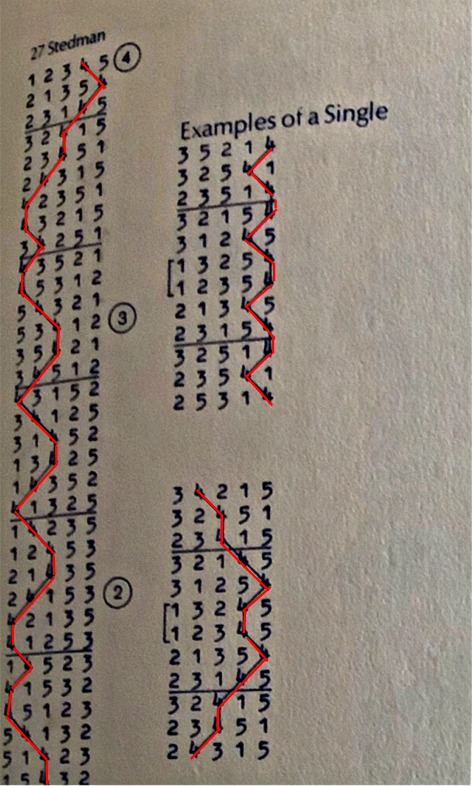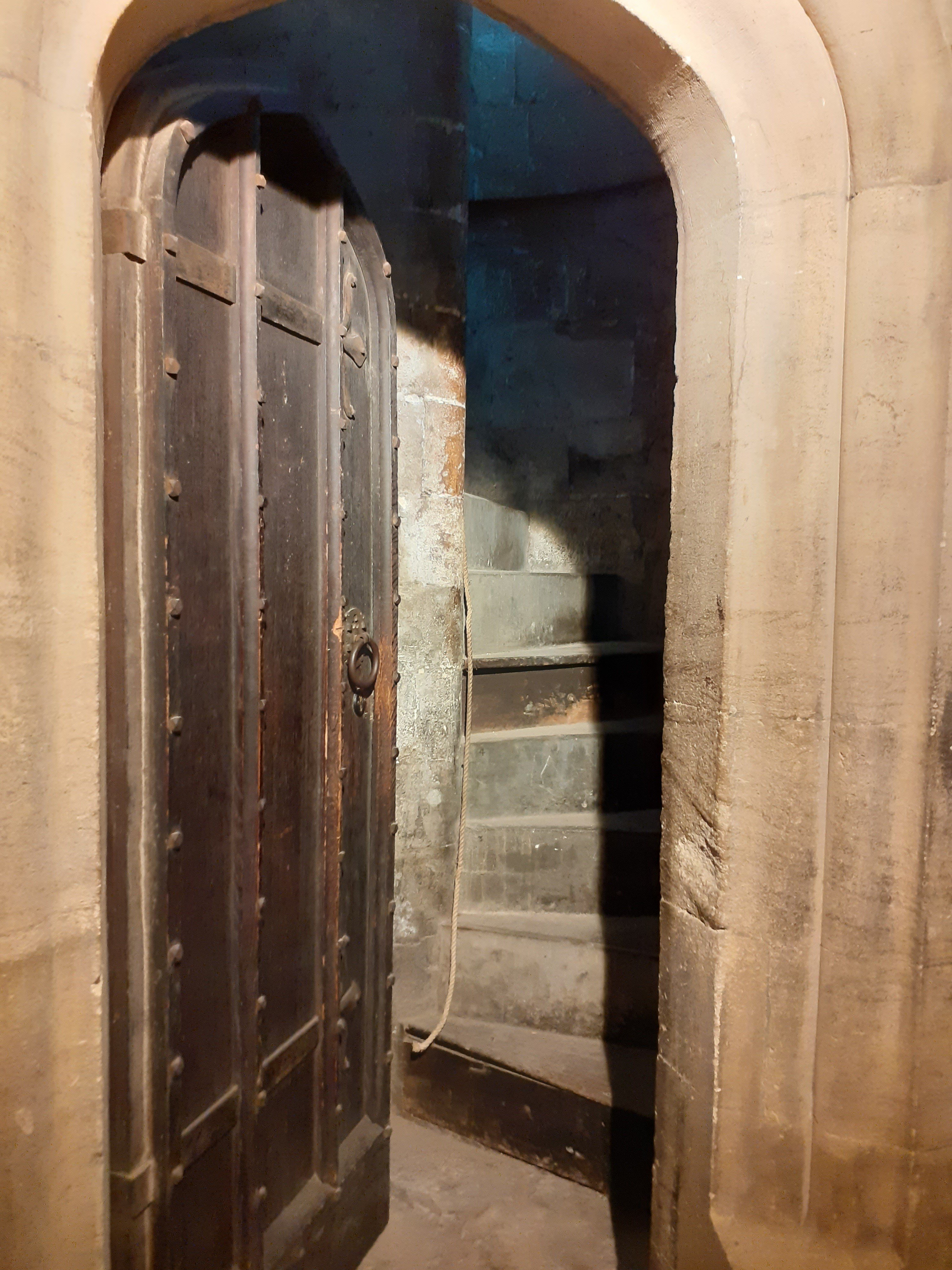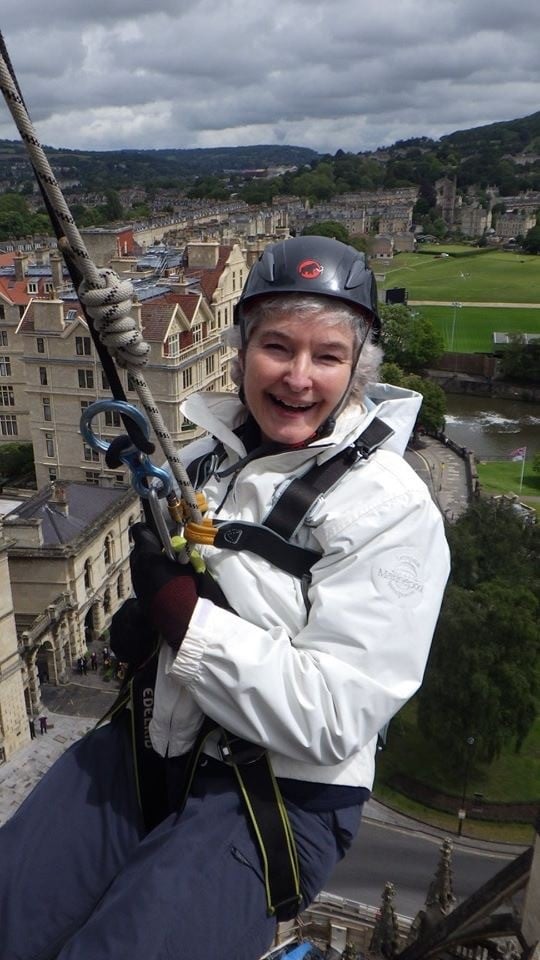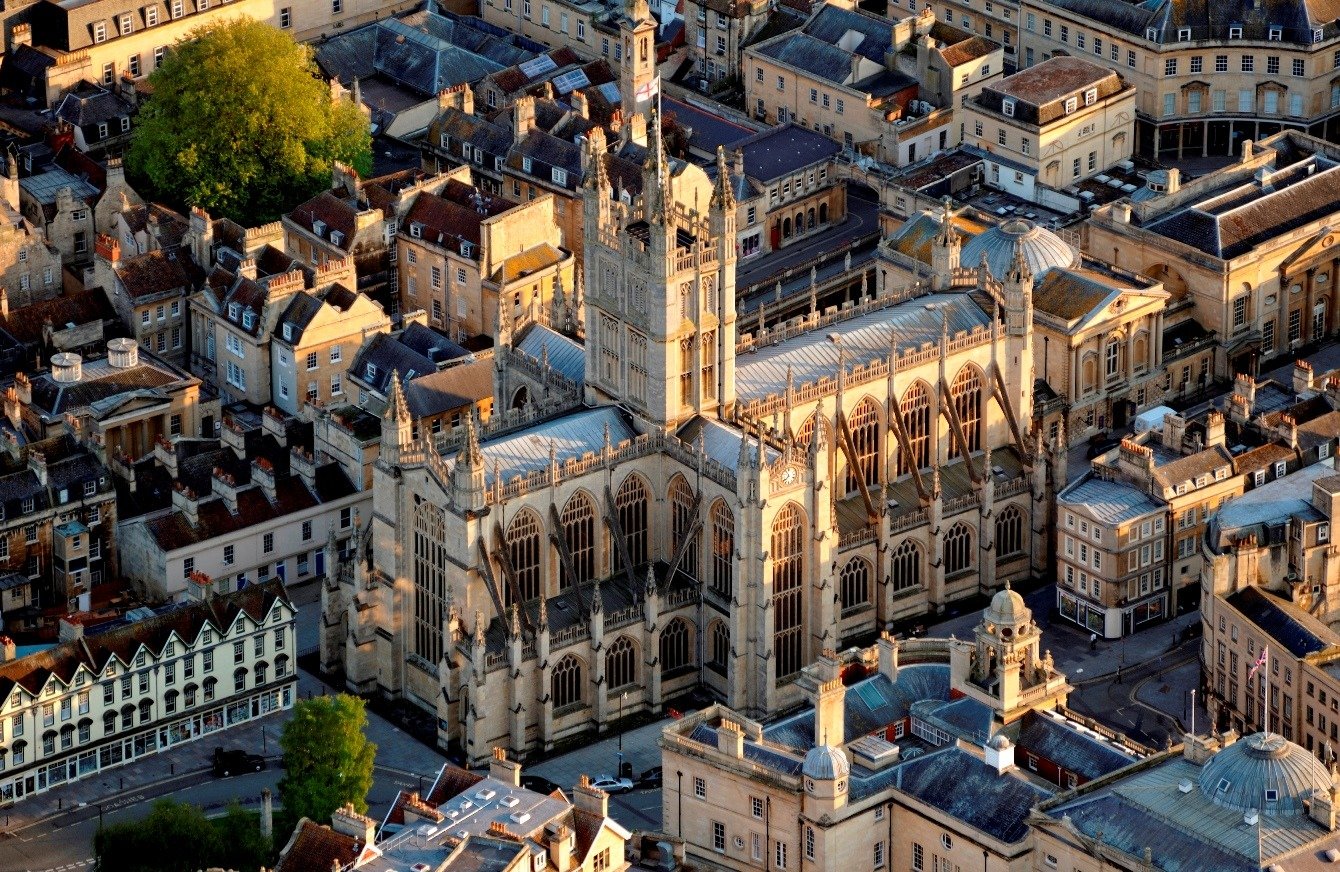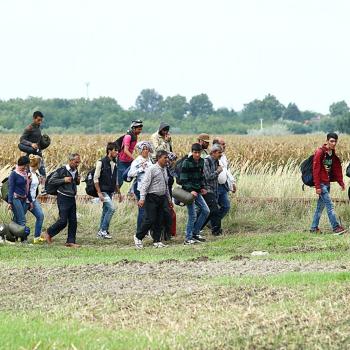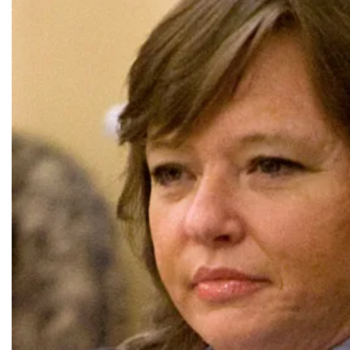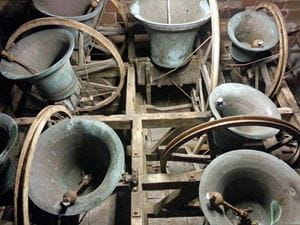
“Religion Behind the Scenes” spotlights the less discussed, but no less crucial, tasks that keep religious communities running, and the people who make it all happen.
From very early in the Judeo-Christian tradition, bells have played a role in sacred worship (e.g., Exodus 28:33). In the 5th century AD, missionaries used handbells to call people to worship. By the 12th century, tower bells were common in England, alerting villagers that church meetings were about to begin. By the mid-17th century, many churches employed bellringers to perform the task—not simply for Sunday services, but for weddings and funerals as well.
While, in much of the world today, church bellringing has died—either no longer being done, or being fully automated, replacing the human component of this seemingly lost art—Veronica Johnstone is a bellringer at Bath Abbey, a Church of England parish church that was founded in the 7th century, and which has been built, rebuilt, and restored in the various centuries since. In this installment of Religion Behind the Scenes, we learn a bit about how church bellringing works, and why someone in the 21st century would want to engage in this important, behind-the-scenes work.
Could you give us a brief rundown on how bellringing in a church, like Bath Abbey, is done?
What we do in Bath is called “change ringing.” Essentially, it is using a series of bells and a group of bellringers to make a tune with the bells. It isn’t necessarily a recognizable tune that one would sing to. However, we are ringing the bells in an organized pattern, making an intentional tune or method.
Because the bells are typically big, each is mounted on a large wheel. Each also has its own separate rope. You pull on a rope, starting the motion of the bell—though it takes a few pulls to get the bell to swing sufficiently for it to ring. When you pull the rope, the clapper falls against the side of the bell. When you pull on the rope again, the bell reverses direction and the clapper then falls on the other side of the bell. Each bellringer pulls their rope in a predetermined order, and that crates the desired melody. You really need to have a sense of rhythm in order to do this. It’s partially sight—watching your fellow ringers; but rhythm is also absolutely necessary. Achieving good striking is more important than the difficulty of the method you’re trying to ring. It is good to learn difficult methods but, especially for service ringing, the quality of the ringing is more important.
Now, it’s called “Change Ringing” because the order in which the bells are rung changes. In “call changes,” one ringer gives commands to the other ringers, changing the order in which the bells are rung. So, you might start out ringing them in this order: 123456, and then the “call change” will be given to switch the order to: 132546. It’s challenging. I do “call changes” at the abbey, and it does my head in sometimes, but I manage to do it. There’s also “Method Ringing,” where each of the ringers memorize the order in which the bells are to be rung—as part of a pre-established continuous pattern, as in the photo above.
Since Bath Abbey has ten bells, do you typically have ten ringers at a time?
Well, ideally. COVID has influenced that. And a lot of our ringers are like me—not in the “first flush of youth,” if you catch my meaning. And the older you get, the harder it gets to ring these large and heavy bells. It's very physical work. Beyond the physical nature of the ringing, there are 120 steps up to the bell tower, where we ring. By the time you get to the top, everyone's breathing heavily. So, we are a bit short on bellringers currently. We hope to get back to ten ringers on Sunday's very soon.
How long have you personally been involved in bellringing?
About 60 years, on and off. I started when I was 11-years old. But, during the years, I only rang if I was worshiping at the church I was ringing at. So, my husband and I had a period when we went to a Baptist church. We've also attended a couple of Evangelical churches, and some churches that just haven't had bells. When attending those churches, I didn't ring. But, during the last sixty-years, when I was attending a church with bells, I’ve rung.
What got you into church bellringing?
Family, mostly. My older sister and my brother next in age to me—they both learned to ring. It was the kids in our family. My parents didn’t ring. No, my father was in the choir, though.
I started in a church where you rang downstairs. There was no belltower that you had to climb. So, you just sort of went into the church, and then you turned left to go bellringing or right to go sit in the pews. So, the bells in that church were more obvious, and they had a very active band of ringers. And I think, you know, we sort of got into it like that. I was also in the choir.
For you, what’s the most sacred side of church bellringing?
I think it's the act of calling people to worship God. It acts as a reminder to the locals that the church is there. I mean, it's very difficult to hide the sound. You know? They ring out across the city. It's a shame, in a way, that we weren't allowed to ring the bells during COVID, because I think that would have helped to remind people that God is still present, even during that difficult time. Obviously, Christians “know” that God is still present, but—you know—there are some people that might have been blessed by the reminder that God and the church were there for them during this very rough patch, and the bells accomplish that. So, I think that sense of offering comfort to people and inviting them to worship God are the most sacred aspects of bellringing for me.
Would you say that doing this work has changed you spiritually or influenced you in positive ways?
It has certainly influenced me in positive ways. That could be because I been doing it for so many years, having sort of started at the age of 11. I became a committed Christian at the age of 14. Both church bellringing and my personal belief in Christianity have been major parts of my life. They’re sort of woven together for me.
Is there an aspect of bellringing that you take pride in?
This might not sound like a big deal, but I can ring some pretty complicated methods. Of course, you know, I'm getting older, and I get forgetful sometimes—and the break during COVID hasn’t helped with that. Because of Covid, I hadn’t been able to ring for over a year. I didn’t want to go back to ringing until I had at least one practice night but, due to a shortage in the number of ringers, I had to dive straight into Sunday ringing. I said a prayer as I took hold of my bell rope, “Lord, please help me.” And He did. Anyway, I’ve learned some complicated patterns over the years, and I feel good about that.
Also, sometimes, when I’m ringing, I’ve really felt the past—all of the ringers down through history, you know? I mean, people were ringing in the 1700s. And sometimes you can just feel that. This is something that's timeless, and it's been calling people to worship for all those years. And it's quite something to be part of that.
Does the rector or priest have any role in the work of the church bellringers?
At the Abbey, especially, there's a lot of consultation with the priest. We have quite a large clergy team. The rector always comes to our bellringers annual general meeting. There is somebody called the “Ringing Master” or the “Tower Captain,” whom we elect, and he or she is the person in charge of all the ringers. They liaise with the clergy on our behalf. There are a surprising number of things we need to discuss with or clear with the clergy there at the abbey. But the rector doesn’t determine what we ring.
So, the bellringers have the freedom to decide the pattern they ring?
Yes, and it really depends on whose there and the level of their abilities. So, the tower captain will know if somebody can only ring a simple method, or if they’re capable of complicated methods. If we've got eight ringers who can ring a complicated method, then we will ring a complex method. But, on the other hand, if we've got ringers who can only do call changes, then we will ring call changes.
All the people who are ringing a complex method have to know that method, and you only know it by learning it. As the [red squiggly] line in the chart [above] shows, it can be quite complex. So, sometimes we do a simple ring where we just call changes here or there. Other times we do a method that requires that the ringers be more informed or prepared.
To ring a method, you need what's called “rope site.” You need to be able to see what the other bellringers are doing. This is necessary because, when you pull on the rope, the sound is not instantaneous. So, you know, because you're moving through the bells, and each bell is weaving a little pattern around the other bells, you've got to be able to think, “Ah, yes, I'm going to follow him now.” And that's called “rope site.” So, as well as learning the method and the line that you're supposed to follow, you've got to be aware of who else is around you and who you are to follow.
Any unusual experiences you've had in your 60-years of church bellringing?
Well, I like going on bell ringing outings. I belong to the diocesan guild and also a national guild. And, until COVID, we used to go on an annual holiday for a week. We've been to Scotland, the Lake District, to Devon, you know, all around. And there is one place that bellringers say, “Oh, have you rung there?” And that's a place called Pershore Abbey (in Worcestershire). It's a bit like Bath Abbey (where I ring), in as much as you go up all these stairs inside the church, and then you walk inside the roof void. And then you come to an opening in the wall, high up—and you go through that opening with a great drop below you, with nothing between you and the church floor about 100-feet below. And there's a tiny little metal staircase of about half a dozen or so steps, and you make your way up there—again, with nothing below you. At the top of those stairs is a big platform on which you ring the bells, suspended in the middle of nowhere 100-feet in the air. If you've got a fear of heights, it’s not the place to be. And when we were there, one or two people crawled up there and turned green.
Also, a couple of years ago—in order to help raise money for a big project they were doing at church—I did what they called the “Leap of Faith,” which was abseiling (or repelling) from the top of the church tower, down to the roof, and then down again to the next level. I've never done abseiling before, but the rector did it as well, and they just asked for volunteers, so I decided I would do it as well. It was for charity. I stood there and I said to myself, “What am I doing? Please help me, God!”
What’s the most common thing, whether positive or negative, that you run up against in bellringing?
I suppose the fact that there are people who occasionally complain about the bells. It upsets them in some way. Maybe they don't like being woken up at 10 o'clock in the morning on a Sunday. I remember, when I was learning to ring, that there was one lady who would keep coming in to complain about the bells. And then she would go away for a bit and then she would come back, and she would stand in the church and shout because we were making such a noise. Very strange! I think maybe some who are upset about it have just gone through a bad time, or perhaps they don't like church. I don’t know.
Are there aspects of bell ringing that might surprise people?
I know lots of people who say, “Oh, don't you have to be musical?” or “Don't have to be good at math?” or “Don’t you have to be strong to ring the bells?” You don't need to be any of those things. What you need is a good sense of rhythm. You’ve got to be able to really listen to what you're doing and feel the necessary timing. Those tend to be the main misconceptions.
What continues to motivate you—particularly at your age, and with so many years of experience—to participate in church bellringing?
The love of it and learning new methods—or ringing ones that are familiar, where I can just sort of stand there and enjoy ringing the method. I very much enjoy the music. When something is well rung it is quite musical, quite beautiful.
Is it deafeningly loud in the room as you ring?
It can be, but it depends on the soundproofing within the church and within the bells. I’ve rung some places where you can't hear what you're ringing. And I've rung in other places where the bells drown you out because there's no soundproofing whatsoever, and you can't hear what you're doing because it's just so loud. But normally, you can hear what you're doing and it's a nice sound, you know, acceptable to the ears.
How has bell ringing changed since you began ringing?
Well, when I started ringing, each person had “their bell.” They were the only ones that rang the sixth bell or the 4th bell (or whatever bell was “theirs”)—and, unless they were ill, no one else rang that bell. Whereas now, you can ring any bell, anybody can ring any bell, if they are physically capable.
How do you see bellringing changing in the future?
Well, it's difficult getting youngsters to learn to ring. And I think part of that is commitment. We do need to get people to help, but it's very difficult getting them to come and participate. Perhaps that’s because the bellringing is attached to a church, and they don't want to go to church. But also, it's no good coming one week, and then not coming back until a month later. If you're learning to ring, you need to do it regularly or you’re not going to get good at it. Once you've learned, you will always be able to ring but, until you’ve learned how, if you don't do it regularly, you'll keep struggling anytime you try.
Is there a high risk that all of this goes fully automated at some point in the future?
Not change ringing. Perhaps chiming—which is done when the mouth of the bell hangs downward. So, like clock hammers, those are automated, aren’t they? And you can get them to play little tunes. So, that aspect of ringing could be totally automated, but I don't think you could ever fully automate change ringing itself. Especially since the bells are rung when facing up (rather than facing downward). I don't think that could ever be automated.
What else should people know about church bellringing?
I suppose one thing is that bells are located in different locations in various churches. So, you can walk into one church and the bells are there, to your left or to your right. Or you can walk into another church and find yourself going up a twisty staircase to a room where the bells are located—which is situated in a tower. There are so many different places where the bells are located in various churches.
You can have bells that are tiny, and (in a way) they’re very difficult to ring, even though you may be able to ring them with one hand. Or you can have great big bells, like the ones in Liverpool Cathedral, and so on. And so, it is different from place to place and church to church—and it’s quite lovely.
Do you know how many places you've rung church bells?
Probably a couple of hundred. Interestingly, the only time I've suffered from vertigo was when I rang at the Chesterfield church. It has a famous twisted spire. We were able to go up and walk around it. And, as I stood at its base and looked up at the spire, I thought, “Oh, no! That's not a good thing to do.” That's the only time I've ever had vertigo in all of the various churches I’ve rung in.
I have never asked this question in the dozens of Religion Behind the Scenes interviews I've done, but do you think God cares about church bellringing? And, if so, why?
Yes, I really do, because we're calling people to worship Him. And we are doing it for the glory of God. How could He not care about that?
Interview conducted, transcribed, edited, and condensed by Alonzo L. Gaskill.
12/6/2022 4:56:20 PM
